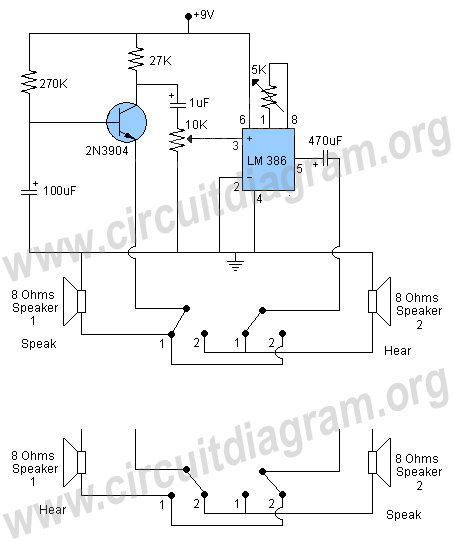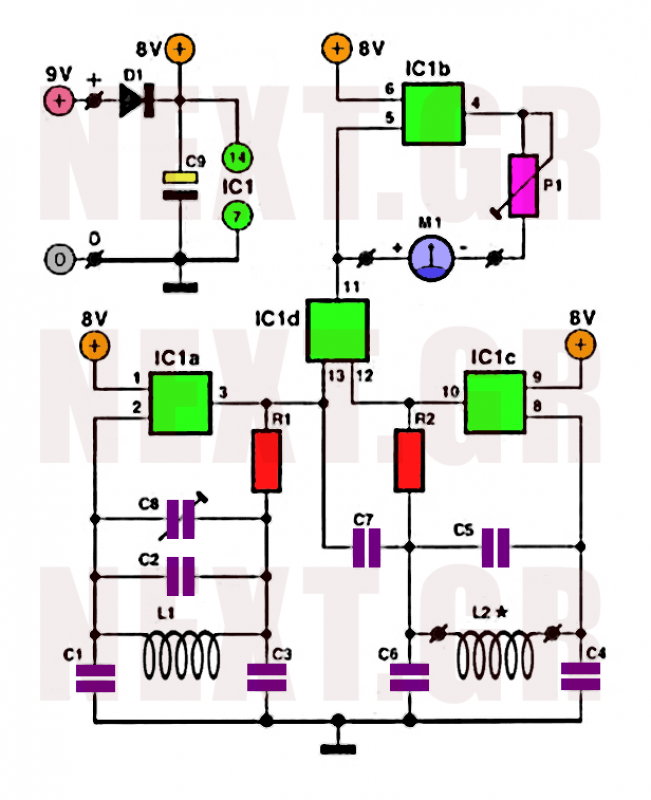
555 Timer IC For Tachometer Circuit Project

The following circuit illustrates a Tachometer Circuit Project. This circuit is constructed using the 555 Timer IC. Features include a monostable IC and voltage capabilities.
The Tachometer Circuit utilizes a 555 Timer configured in monostable mode to measure the rotational speed of an object, typically in revolutions per minute (RPM). The circuit operates by detecting the pulses generated by a rotating shaft, which are then converted into a corresponding voltage signal that can be easily interpreted.
In the circuit, the 555 Timer is connected to a sensor that produces a pulse for each rotation of the shaft. This pulse is fed into the trigger input of the 555 Timer, causing it to output a high signal for a duration determined by the resistor and capacitor values connected to it. The output pulse width is proportional to the frequency of the input pulses, which directly correlates to the speed of rotation.
The configuration includes a power supply, typically 5V to 15V, which powers the 555 Timer. The timing components, a resistor (R) and a capacitor (C), are selected based on the desired time constant for the output pulse. The relationship between the timing components and the output frequency can be expressed using the formula:
\[ T = 1.1 \times R \times C \]
where \( T \) is the time period of the output pulse.
To display the measured RPM, a digital voltmeter or an analog meter can be connected to the output of the 555 Timer. The output voltage can be calibrated to correspond to specific RPM values, allowing for easy reading and interpretation of the results.
Overall, this Tachometer Circuit is a practical application of the 555 Timer IC, showcasing its versatility in timing applications and its ability to interface with other components to create a functional speed measurement system.The following circuit shows about Tachometer Circuit Project. This circuit built based on the 555 Timer IC. Features: monostable IC, voltage .. 🔗 External reference
The Tachometer Circuit utilizes a 555 Timer configured in monostable mode to measure the rotational speed of an object, typically in revolutions per minute (RPM). The circuit operates by detecting the pulses generated by a rotating shaft, which are then converted into a corresponding voltage signal that can be easily interpreted.
In the circuit, the 555 Timer is connected to a sensor that produces a pulse for each rotation of the shaft. This pulse is fed into the trigger input of the 555 Timer, causing it to output a high signal for a duration determined by the resistor and capacitor values connected to it. The output pulse width is proportional to the frequency of the input pulses, which directly correlates to the speed of rotation.
The configuration includes a power supply, typically 5V to 15V, which powers the 555 Timer. The timing components, a resistor (R) and a capacitor (C), are selected based on the desired time constant for the output pulse. The relationship between the timing components and the output frequency can be expressed using the formula:
\[ T = 1.1 \times R \times C \]
where \( T \) is the time period of the output pulse.
To display the measured RPM, a digital voltmeter or an analog meter can be connected to the output of the 555 Timer. The output voltage can be calibrated to correspond to specific RPM values, allowing for easy reading and interpretation of the results.
Overall, this Tachometer Circuit is a practical application of the 555 Timer IC, showcasing its versatility in timing applications and its ability to interface with other components to create a functional speed measurement system.The following circuit shows about Tachometer Circuit Project. This circuit built based on the 555 Timer IC. Features: monostable IC, voltage .. 🔗 External reference





